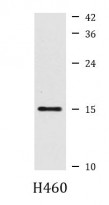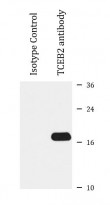ARG58091
anti-TCEB2 antibody
anti-TCEB2 antibody for Immunoprecipitation,Western blot and Human,Mouse
Overview
| Product Description | Rabbit Polyclonal antibody recognizes TCEB2 |
|---|---|
| Tested Reactivity | Hu, Ms |
| Tested Application | IP, WB |
| Host | Rabbit |
| Clonality | Polyclonal |
| Isotype | IgG |
| Target Name | TCEB2 |
| Antigen Species | Human |
| Immunogen | Recombinant fusion protein corresponding to aa. 1-118 of Human TCEB2 (NP_009039.1). |
| Conjugation | Un-conjugated |
| Alternate Names | SIII; Elongin-B; RNA polymerase II transcription factor SIII subunit B; EloB; SIII p18; ELOB; Elongin 18 kDa subunit; Transcription elongation factor B polypeptide 2 |
Application Instructions
| Application Suggestion |
|
||||||
|---|---|---|---|---|---|---|---|
| Application Note | * The dilutions indicate recommended starting dilutions and the optimal dilutions or concentrations should be determined by the scientist. | ||||||
| Positive Control | H460 | ||||||
| Observed Size | 15 kDa |
Properties
| Form | Liquid |
|---|---|
| Purification | Affinity purified. |
| Buffer | PBS (pH 7.3), 0.02% Sodium azide and 50% Glycerol. |
| Preservative | 0.02% Sodium azide |
| Stabilizer | 50% Glycerol |
| Storage Instruction | For continuous use, store undiluted antibody at 2-8°C for up to a week. For long-term storage, aliquot and store at -20°C. Storage in frost free freezers is not recommended. Avoid repeated freeze/thaw cycles. Suggest spin the vial prior to opening. The antibody solution should be gently mixed before use. |
| Note | For laboratory research only, not for drug, diagnostic or other use. |
Bioinformation
| Database Links |
Swiss-port # P62869 Mouse Transcription elongation factor B polypeptide 2 Swiss-port # Q15370 Human Transcription elongation factor B polypeptide 2 |
|---|---|
| Gene Symbol | TCEB2 |
| Gene Full Name | transcription elongation factor B (SIII), polypeptide 2 (18kDa, elongin B) |
| Background | This gene encodes the protein elongin B, which is a subunit of the transcription factor B (SIII) complex. The SIII complex is composed of elongins A/A2, B and C. It activates elongation by RNA polymerase II by suppressing transient pausing of the polymerase at many sites within transcription units. Elongin A functions as the transcriptionally active component of the SIII complex, whereas elongins B and C are regulatory subunits. Elongin A2 is specifically expressed in the testis, and capable of forming a stable complex with elongins B and C. The von Hippel-Lindau tumor suppressor protein binds to elongins B and C, and thereby inhibits transcription elongation. Two alternatively spliced transcript variants encoding different isoforms have been described for this gene. Pseudogenes have been identified on chromosomes 11 and 13. [provided by RefSeq, Aug 2008] |
| Function | SIII, also known as elongin, is a general transcription elongation factor that increases the RNA polymerase II transcription elongation past template-encoded arresting sites. Subunit A is transcriptionally active and its transcription activity is strongly enhanced by binding to the dimeric complex of the SIII regulatory subunits B and C (elongin BC complex). The elongin BC complex seems to be involved as an adapter protein in the proteasomal degradation of target proteins via different E3 ubiquitin ligase complexes, including the von Hippel-Lindau ubiquitination complex CBC(VHL). By binding to BC-box motifs it seems to link target recruitment subunits, like VHL and members of the SOCS box family, to Cullin/RBX1 modules that activate E2 ubiquitination enzymes. [UniProt] |
| Cellular Localization | Nucleus. [UniProt] |
| Calculated MW | 13 kDa |
Images (2) Click the Picture to Zoom In
-
ARG58091 anti-TCEB2 antibody WB image
Western blot: 25 µg of H460 cell lysate stained with ARG58091 anti-TCEB2 antibody at 1:1000 dilution.
-
ARG58091 anti-TCEB2 antibody IP image
Immunoprecipitation: 150 µg extracts of MCF7 cells were immunoprecipitated and stained with ARG58091 anti-TCEB2 antibody at 1:500 dilition.







